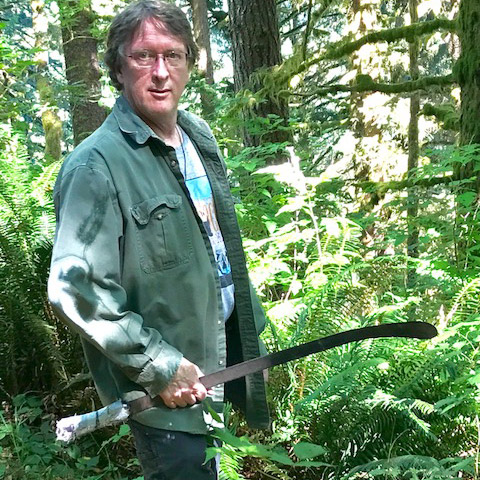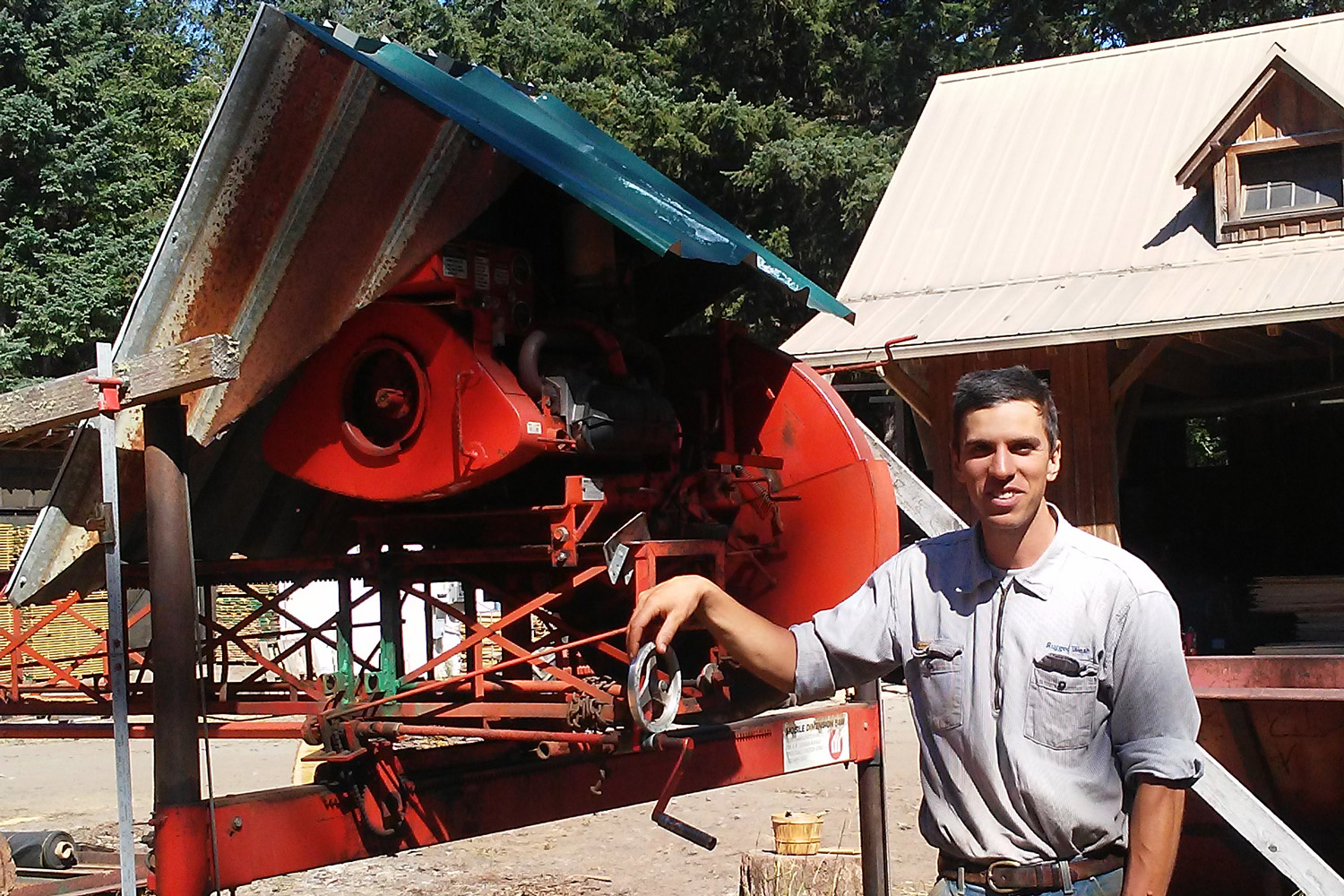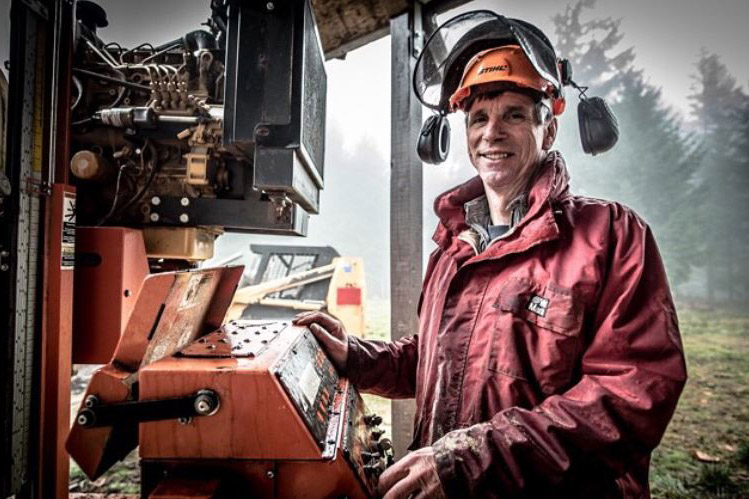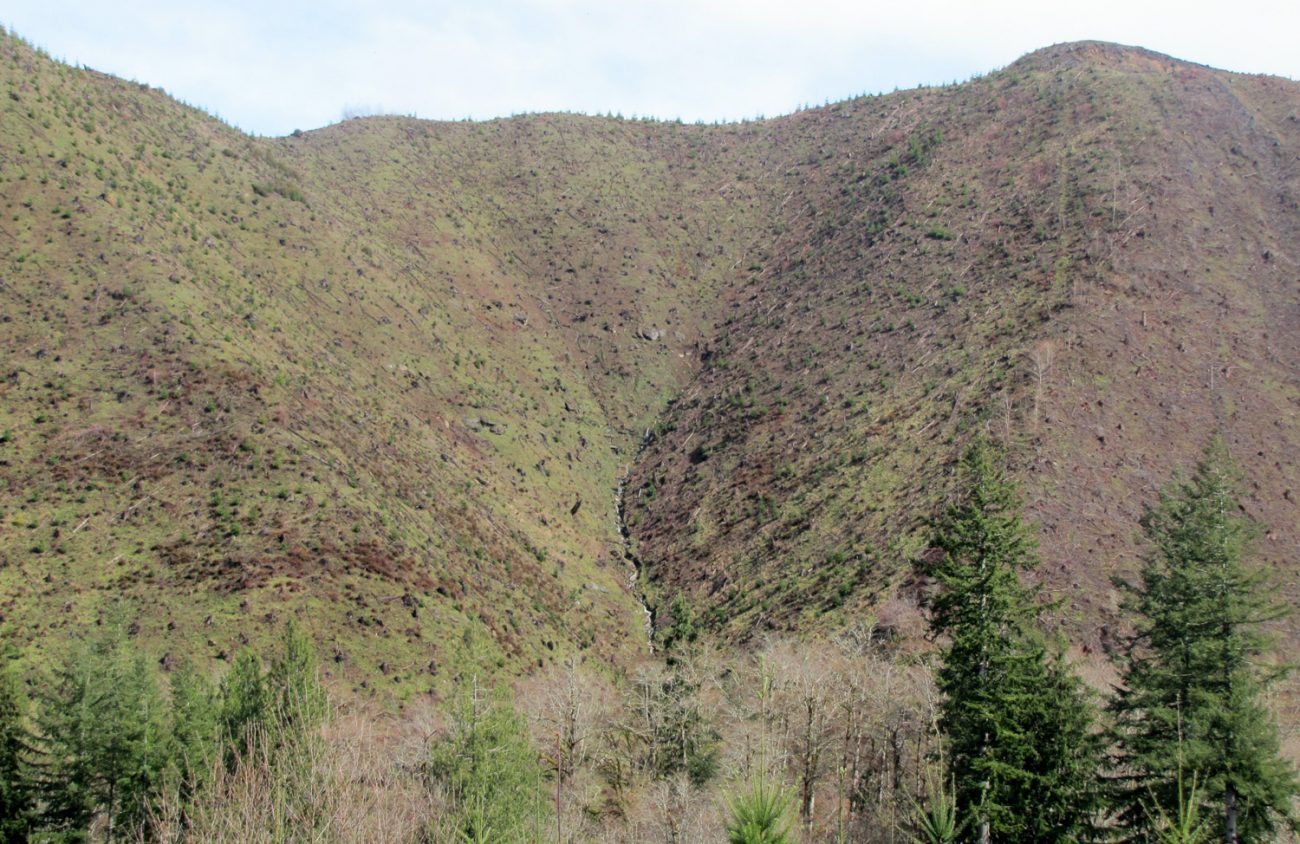Don Andre hacks at an overgrown trail with a machete on a 17-acre community-owned forest, within earshot of Highway 20 a couple miles east of Newport. The machete, which his father found at a yard sale years ago, curves forward at the tip, which helps power the overhead volleys he directs at the branches.
Andre spent much of his youth exploring forests like this one outside his family’s home in Agate Beach north of Newport. The giant old trees of the coastal rainforest provided an endless playground where he was free to tramp around until his mom called him back home by laying on the horn of the family’s Chevy truck.
After leaving the sleepy Oregon Coast to travel and pursue higher education, in the mid-’70s Andre came home to a shock: The forest of his youth, where his imagination and young legs once ran wild, was no more. The clearcut land so dismayed and infuriated Andre that, to this day, he’d rather not visit.
While Andre still feels the pain of losing his childhood stomping grounds, he says he tries to focus on positive change rather than his grievances with the timber industry.
The organization he helped found, the Oregon Coast Community Forest Association (OCCFA), is part of a growing movement to reimagine the relationship between timber communities and the forests that surround their homes. Across the state, Oregonians are working to develop forest management techniques and economic models that preserve forests for multiple uses.
This movement is much akin to the organic and slow food movement. Forest owners and timber communities are envisioning a timber economy that balances a healthy landscape with quality products and fair compensation for workers. And they’re counting on people caring about where their wood comes from.
Enlarge

Photo Courtesy Don Andre.
Alternative forestry models go by many names: regenerative forestry, sustainable forestry, resilient forestry and carbon-smart forestry. While there isn’t one definition of these practices, they offer clear contrasts to the industrial timber model: Forests are managed for species and age diversity and not planted as single species tree crops, overall forest cover is maintained, logging near waterways is off-limits, harvest levels are lower than growth rates, and herbicide use is targeted rather than used on an entire plot.
Because the scale and intensity of these practices lacks the efficiency of corporate forestry, it cannot compete on the open market. The future success of this model depends on the public recognizing other kinds of forest values and demanding a forestry approach that values trees for more than their timber.
As advocates of alternative forestry push away from traditional forestry, they’re using a variety of tools to realize this vision.
Woodlot owners are connecting with customers who want locally and sustainably produced wood. Communities are working with conservation-minded foresters to produce timber while protecting watersheds and wildlife.
Conservation groups and public utilities are working with landowners to preserve and improve habitat and watersheds through easements and land acquisitions. Economists are looking at market and legislative solutions to improve rural economies as they move away from the corporate forestry model.
Though the methods vary, the concerns are the same: maintaining healthy rural economies and healthy forest ecosystems.
An industry and environment in decline
The Oregon timber industry has been in decline since the 1980s. Market factors, concerns over habitat destruction and increased automation of timber falling and milling have taken significant chunks out of the timber economy.
Data compiled by Josh Lehner at the Oregon Office of Economic Analysis show a steady decline in wood industry jobs from between 60,000 and 90,000 in 1950-1980 to below 45,000 since 2000. While timber jobs have declined by about half since their peak in the 1950s, Oregon’s population has more than doubled.
Today about 75 percent of the timber harvest in Oregon comes from corporate timber companies, according to information from the Oregon Forest Resources Institute, an industry sponsored group. Industrial timberland accounts for about 6 million acres in Oregon, about 20 percent of the state’s overall forestland.
Milled logs have been cut and processed, adding value to them. Depending on market dynamics, as many as one in five logs exported from Oregon is unmilled, which reduces the value added to Oregon timber in favor of market efficiencies and reduces the lumber availability for local mills.
The timber industry embraces a plantation model based on clearcutting and replanting, predominantly with the economically valuable and fast-growing Douglas fir. This model is practically mandated by the Oregon Forest Practices Act (OFPA), which requires replanting of harvested areas and suppression of competition in replanted stands.
The plantation requirement leads to one of the most controversial practices of modern forestry — aerial pesticide spraying. A rash of complaints over health impacts and concerns over water contamination from pesticide drift has generated campaigns to ban the practice. In Lincoln County a ballot initiative to ban aerial spraying of pesticides narrowly won earlier this year. Advocates are eyeing more local and perhaps statewide bans in the future.
Marketing sustainable timber
As you scan the aisles in nearly every grocery store you see a growing share of organic groceries and “buy local” marketing. According to a 2016 report by USDA, the organic food market grew by 300 percent between 2002 and 2015 and continues to show sustained double-digit growth.
Ben Deumling of Zena Forest Products says the wood market isn’t as direct or developed as the organic food market, but the latter is a good model for wood producers in Oregon. He sees similar opportunities to grow a woods-product industry built on a sustainable relationship with the land and consumer’s desire to buy local.
Deumling, who’s in his mid-thirties, spoke to EW at the family mill with his infant son cradled against his chest. With a big smile, short dark hair and a wiry build, Ben Deumling runs the mill and his mother, Sarah Deumling, manages timber harvests on more than 1,000 acres in the Eola Hills outside Salem. The Deumlings employ four full-time mill workers and crews of around a dozen seasonal workers. With three generations living on the property, maintaining a healthy forest for the future and making a living now are of equal importance.
“We try to just tell a different story and tap into a different market,” Ben Deumling says.
Telling their story and inviting people to tour their forest has resonated with customers who are concerned about how their wood is produced, he says. It’s also important, he says, that Zena can add value to its products by milling the timber onsite before they go to market.
While Zena has been successful in marketing their hardwood products, which often become furniture and flooring, the market for Douglas-fir lumber and other softwood products offers fewer opportunities. “It’s embarrassing that there’s no continuity between the forest and the end user,” Deumling says. “Regardless of the product there’s a desire on the part of the customer to hear that story.”
“I would love to be able to go to Parr Lumber and have a grown-in-Oregon stamp rather than a grown-in-Chile stamp,” he says. “That’s a step in the right direction, but then the next question is not only where was it grown but how was it grown.”
Enlarge

Photo courtesy Peter Hayes
About an hour north of Zena, Peter Hayes of Hyla Woods is working on telling a similar tale. Hayes wears a practical outfit of running shoes, shorts, a blue button-up shirt and a gray hat as we tour the Mount Richmond forest outside of Gaston. Hayes is a fifth-generation woodsman with a penchant for experimentation. He sees the development of a more ecologically informed forestry as a way to build capital for the future while continuing to produce timber.
But so far he hasn’t been able to tap the local market for sales of construction staples like two-by-fours. Hayes refers to the wood going to local markets from Hyla Woods as the “appetizers and desserts.” Regardless of their intent to keep their wood in local markets, much of their wood is still exported.
One solution Hyla Woods, like Zena Forest Products, embraces is adding value to their timber by milling onsite and making products like cutting boards. The cutting boards Hyla Woods sells are stamped with the coordinates of the forest they were harvested from. Hayes says the idea is for consumers to be able to look at a satellite photo online and see that where the wood came from is still a forest.
Hyla Woods collects data on the growth of the forest and the health of the habitat. “We are one of the few forests that can actually quantify our biodiversity,” Hayes says. He says in the long-term he could see people investing in the biodiversity provided by their forest, but options for entering into the carbon market have yet to meet their expectations for forest management.
“We’ve probably been approached by 20 different outfits that have wanted to buy our carbon,” Hayes says. He says Hyla Woods is interested in getting credit for their carbon but don’t want to enter the market until they’re sure they will get a fair price. While Hyla isn’t managing exclusively for carbon, their holistic approach does increase the carbon stored in the forest. Hayes says that in a given year they only cut about 25 percent of the growth in the forest, which means that they are producing more timber and sucking in more carbon each year.
For The Joinery, which just celebrated its 35-year anniversary, timber operations like Zena Forest Products and Hyla Woods are a meaningful part of their business. The Portland furniture company has 35 employees and produces furniture and cabinetry, primarily from locally sourced hardwoods.
Jon Blumenauer, CEO of The Joinery and son of Oregon Congressman Earl Blumenauer, a Democrat from Portland, says “they help support our business and we help support them. A common denominator is an alignment of values.”
The craftsmanship and quality of their products must stand on its own merits, Jon Blumenauer says, but “for a lot of folks it makes a difference that we source local wood.”
Communities take charge of their forests
“If you think about secure communities and you think about safety and security and self-sufficiency — what is more important than being in charge of your own water?” Don Andre asks. “I can hope that some distant corporate bigwigs would care about my water, but I’m guessing that I’m going to care about the water near my home more than they are.”
One of the first campaigns of the Oregon Coast Community Forest Association was to work with the city of Toledo, near Newport, to manage the forest in its watershed and protect its water supply. In developing a plan for the forests in the watershed, the city isn’t foregoing logging completely but crafting a strategy that integrates a healthy watershed with a productive forest.
Toledo hired Trout Mountain Forestry to achieve these goals through a timber management plan. Included in the plan is a desire on the part of the city to support the local economy by encouraging access to forest products for local artisans, woodworkers and foragers, a major focus of OCCFA.
Mark Miller, a partner in Trout Mountain Forestry, has worked at forestry with a conservation objective for three decades. He says demand for the services the company provides has been steadily increasing. Trout Mountain manages multiple watersheds for municipal governments across Western Oregon, including a 2,352-acre portion of the Rock Creek Watershed for the city of Corvallis.
Because they’re tasked with managing the forests for water quality, Trout Mountain’s operations are trying to change plantation forests into forests that are best suited to the city’s goals. Miller says that one of their objectives is to create older and more diverse forests that consistently supply clean, high quality water.
In order to create a more diverse forest structure, Trout Mountain thins plantations and creates gaps in the forest to more closely mimic natural processes. Unlike typical plantations, they also maintain hardwood species and leave legacy trees. They create habitat such as snags, which are often missing in plantation ecosystems, and use existing skid trails and roads whenever possible to minimize their impact on the forest soil.
“It’s still active management,” Miller explains. “But we’re growing older, more varied forests and keeping reserve areas with more habitat. You can both generate income and protect important features of the forest.”
Sales of timber from the city-owned property help pay for other projects like habitat enhancement. Trout Mountain’s plan for Corvallis has a 50-year outlook and, according to Miller, will see an increase in the timber on the property that can be harvested without diminishing other management objectives.
Worth more than wood
“My dad instilled in me that you should be able to eat the fish out of your river and swim in your river,” Paul Engelmeyer says. Engelmeyer, who has a thick walrus-like mustache and wavy gray hair, lives in Yachats and focuses his conservation work in communities on the Oregon Coast. He works with conservation partners like the Audubon Society and the Siuslaw National Forest to connect landowners with opportunities to protect healthy forests.
Engelmeyer says easements and acquisitions are a new tool to help landowners preserve their forests. By tapping into different funding pots, including habitat funds from the Bonneville Power Administration, federal endangered species funds, gambling revenues and taxes on oil extraction, Engelmeyer can help people get compensated for preserving forestland.
“It’s a big pile of money and people aren’t hip to it,” Engelmeyer says. He says his work is gaining traction because “there’s a mindset change where people are dedicated to the land, not just using it to make a living.”
Strategies to protect forests for their habitat and impact on water quality also extend to municipalities. Unlike Corvallis, which owns much of the forest in its watershed, Eugene has little say in how the forests in its watershed are managed.
In order to promote stewardship that keeps water clean and treatment costs down, Eugene Water and Electric Board and the McKenzie River Trust work with landowners to set up conservation easements and recruit “clean water partners.” The program connects landowners with resources and incentives to protect habitat and water resources.
“It’s hard to look at and quantify what the forest provides besides timber,” says Karl Morgenstern, the source water protection coordinator for EWEB. “Healthy forests reduce the costs of water treatment.”
By incentivizing landowners to either keep their watershed intact or restore degraded watersheds, the program works to keep down costs associated with treating water.
Natural resource economist Ernie Niemi says, “When you have abundance and you diminish supply, consequences are minimal.” He says that because we don’t typically think of forest goods like fish, habitat and clean water in economic terms it’s harder to understand the role they play in the economy. “The challenge is understanding the trade-off and making it.”
For Niemi, branding and marketing activities such as those embraced by Zena Forest Products and Hyla Woods are a good start, but are limited in their ability to restructure the market.
He sees a market intervention as having more potential to transform the forest products industry.
“We can create markets that would create movement towards positive outcomes,” Niemi says. A tax on carbon polluters that funds green initiatives like conserving forests could compensate forest owners for responsible management, he adds. “Money communicates clearly in a message that can be heard.”
John Talberth, president and founder of the Center for Sustainable Economy (CSE), says that carbon markets are “small potatoes” in their impact on the forestry industry. He says a more direct forest carbon tax and reward legislation could transform the timber industry and benefit both rural economies and the environment.
Talberth says that research from CSE and data from the Oregon Global Warming Commission shows the forestry industry is the number one emitter of greenhouse gases in the state. He says the argument that forestry is carbon neutral is built on a fallacy that gives the industry credit for carbon capture on public and small forest owner lands and fails to address the deforestation and emissions generated by industrial forestry.
“What we really need is to reform forest laws to make carbon-smart forests,” Talberth says. He proposes taxing the forestry industry for the emissions and carbon capture reductions they are responsible for and investing the money from that tax into more sustainable and diverse forestry models.
Cutting on a smaller scale and managing for diversity is more labor intensive than industrial clearcuts and would create more jobs in rural communities, he says. “Oregon would be investing in a highly skilled workforce that knows how to cut for timber and leave a climate smart forest.” Because other countries are interested in fighting climate change through smarter forestry, “Oregon could be a leader in spreading this technology,” Talberth says.
A forest for the future
Healthy forests can provide a wide range of economic and ecological values. Businesses such as Zena Forest Products, Hyla Woods and Trout Mountain Forestry are working to create forestry models that value forests for more than timber, while economists and conservationists figure out how to make those models economically and ecologically feasible.
The natural forests of Oregon’s Coast Range are among the most important ecosystems for trapping carbon and muting the effects of climate change. In a state with a growing population and burgeoning tourism industry, the value of forests for clean and cold water and as places to recreate continues to grow. Forestry that produces timber while increasing biomass and habitat can create more jobs because it requires a more hands on process than clearcutting.
Enlarge

Photo: Carl Segerstrom
Zena’s Ben Deumling, a fifth-generation Oregonian, says we need to slow down our thinking and take a longer view of the value of forests. He calls the industrial model of short tree rotations “a race to the bottom of how fast can we grow small trees.”
“We’re shifting that and trying to stretch that back out again to grow big high quality trees that not only make really high quality lumber — but also build diverse forests with old trees and young trees.”
“It is a labor of love but hopefully a labor of love that will continue to be appreciated and worked with for future generations,” Deumling says. “I feel a lot of pride in being from Oregon, and hopefully I can help continue that legacy.”
